In the midst of the daily publication of new journal papers that warrant attention, books are often set aside for reading. Much like many other busy researchers, EIUI team members find time during the summer to catch up. Because the science-policy interface arena is very active globally, the line-up of new books in this field is far-reaching in scope and interest. The following volumes, currently under the reading lenses of three EIUI team members, illustrate this breadth.
Evidence-based policymaking: Envisioning a new era of theory, research, and practice
Karen Bogenschneider & Thomas J. Corbett
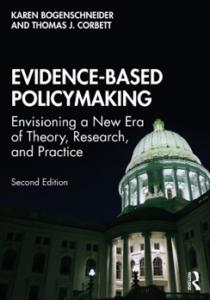 Literature about evidence-based decision making is growing rapidly, offering new insights about immensely complex social processes. This second edition of Evidence-based policymaking aims to offer a “fresh perspective on … [a] persistent conundrum – why is research ignored when we make public policy?” Drawing on their own extensive research on public policy decision processes in the United States, Bogenschneider and Corbett write about approaches used by researchers who were “successful in bridging the research/policy divide” and about policy makers who explained “why and how they use research.” The opportunity to increase understanding from these perspectives alone warrants reading this book. The authors claim that they are not naïve, however. They note that “more systematic interactions are needed with research producers, research consumers, and knowledge brokers” and that further research is needed about how to “effectively communicate research evidence for policy consumption.” Nonetheless, this book may be selected as the text for our graduate course on Information in Public Policy and Decision Making. (BHM)
Literature about evidence-based decision making is growing rapidly, offering new insights about immensely complex social processes. This second edition of Evidence-based policymaking aims to offer a “fresh perspective on … [a] persistent conundrum – why is research ignored when we make public policy?” Drawing on their own extensive research on public policy decision processes in the United States, Bogenschneider and Corbett write about approaches used by researchers who were “successful in bridging the research/policy divide” and about policy makers who explained “why and how they use research.” The opportunity to increase understanding from these perspectives alone warrants reading this book. The authors claim that they are not naïve, however. They note that “more systematic interactions are needed with research producers, research consumers, and knowledge brokers” and that further research is needed about how to “effectively communicate research evidence for policy consumption.” Nonetheless, this book may be selected as the text for our graduate course on Information in Public Policy and Decision Making. (BHM)
The science of citizen science
Katrin Vohland, Anne Land-Zandstra, Luigi Ceccaroni, Rob Lemmens, Josep Perelló, Marisa Ponti, Roeland Samson, & Katherin Wagenknecht, (Eds.)
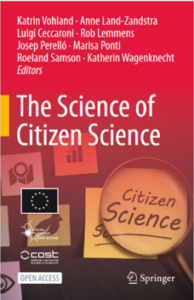 The role of citizen science in knowledge creation, improving scientific literacy, and impacting research and societal outcomes is widely acknowledged. This book is a step forward in the field, bringing together the contributions of over 100 authors in a single volume. In 26 chapters, readers can learn about topics ranging from the impact of citizen science across multiple fields, ethical challenges, societal impact, and practical tools to support citizen science. The book provides best practices and recommendations for each of the topics discussed, creating space for opportunities to reflect about and adopt parts of the practices to amplify the value of the field. The target audience of this book is not limited to citizen science aspirants, but extends to the scientific community, practitioners, policymakers, and academics. While some question the use of the name citizen science, as a newcomer to the subject I have found The science of citizen science to be very informative. (TM)
The role of citizen science in knowledge creation, improving scientific literacy, and impacting research and societal outcomes is widely acknowledged. This book is a step forward in the field, bringing together the contributions of over 100 authors in a single volume. In 26 chapters, readers can learn about topics ranging from the impact of citizen science across multiple fields, ethical challenges, societal impact, and practical tools to support citizen science. The book provides best practices and recommendations for each of the topics discussed, creating space for opportunities to reflect about and adopt parts of the practices to amplify the value of the field. The target audience of this book is not limited to citizen science aspirants, but extends to the scientific community, practitioners, policymakers, and academics. While some question the use of the name citizen science, as a newcomer to the subject I have found The science of citizen science to be very informative. (TM)
Science on a mission: How military funding shaped what we do and don’t know about the ocean
Naomi Oreskes
 Naomi Oreskes, a Harvard faculty member, is a notable historian of science who frequently engages in public discussion about science-policy interface subjects. Her 2010 book, Merchants of doubt: How a handful of scientists obscured the truth on issues from tobacco smoke to climate change, is a classic. Thus, when Science on a mission was released earlier this year, this book was placed at the top of my reading list. It’s a hefty volume and thoroughly researched (the notes and bibliography take up 209 pages). The world’s ocean is vast and fulfills an essential role for life on the planet. The importance of this role has become increasingly clear as the effects of climate change are being felt globally. While extensive research over the past half century has provided windows on the many thousands of species that occupy marine waters and the geography of ocean depths, much is still not known. How we learned what we now know is what Oreskes lays out in this book, particularly the major role that the US military played in funding and directing research. Does it matter who funds research? According to Oreskes: “Every history of science is a history both of knowledge produced and of ignorance sustained.” In the case of over dependence on military funding with its emphasis on physical aspects of the ocean, marine life was largely overlooked. Today, we cannot close our eyes to the significance of marine biodiversity for all of life on earth. I expect to learn much about research funding, research production, and research use in the nine chapters plus conclusion of this book. (BHM)
Naomi Oreskes, a Harvard faculty member, is a notable historian of science who frequently engages in public discussion about science-policy interface subjects. Her 2010 book, Merchants of doubt: How a handful of scientists obscured the truth on issues from tobacco smoke to climate change, is a classic. Thus, when Science on a mission was released earlier this year, this book was placed at the top of my reading list. It’s a hefty volume and thoroughly researched (the notes and bibliography take up 209 pages). The world’s ocean is vast and fulfills an essential role for life on the planet. The importance of this role has become increasingly clear as the effects of climate change are being felt globally. While extensive research over the past half century has provided windows on the many thousands of species that occupy marine waters and the geography of ocean depths, much is still not known. How we learned what we now know is what Oreskes lays out in this book, particularly the major role that the US military played in funding and directing research. Does it matter who funds research? According to Oreskes: “Every history of science is a history both of knowledge produced and of ignorance sustained.” In the case of over dependence on military funding with its emphasis on physical aspects of the ocean, marine life was largely overlooked. Today, we cannot close our eyes to the significance of marine biodiversity for all of life on earth. I expect to learn much about research funding, research production, and research use in the nine chapters plus conclusion of this book. (BHM)
Earth 2020: An insider’s guide to a rapidly changing planet
Philippe Tortell, (Ed.)
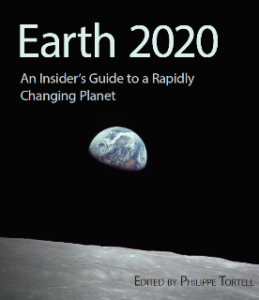 This is a book of 28 short insightful essays, by many noted authors, brought together to help celebrate the 50th anniversary of the first Earth Day (1970). Topics range from politics and law, to biodiversity, the state of the oceans, climate change, and the role of media in environmental affairs. Each piece is stimulating and informative reading, guaranteed to fuel the future endeavours on all those working in the environmental field. By reading an essay each day, one is reminded of the contributions of many fields of study to tackling the urgent problems facing our rapidly changing planet. (PGW)
This is a book of 28 short insightful essays, by many noted authors, brought together to help celebrate the 50th anniversary of the first Earth Day (1970). Topics range from politics and law, to biodiversity, the state of the oceans, climate change, and the role of media in environmental affairs. Each piece is stimulating and informative reading, guaranteed to fuel the future endeavours on all those working in the environmental field. By reading an essay each day, one is reminded of the contributions of many fields of study to tackling the urgent problems facing our rapidly changing planet. (PGW)
Learning policy, doing policy: Interactions between public policy theory, practice, and teaching
Trish Mercer, Russell Ayres, Brian Head, & John Wanna, (Eds.)
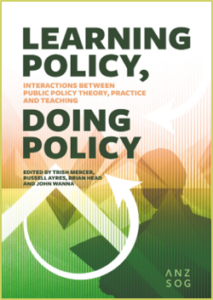 Policymaking from the perspective of practitioners is the focus of Learning policy, doing policy. This volume, edited by Australian scholars, highlights the importance of remembering that context matters when considering science-policy interfaces. The Australian and New Zealand focus is a good reason to read this book and insights based on the work of public servants will be particularly informative. Chapter 5 (“How do policy professionals in New Zealand use academic research in their work” by Karl Löfgren and Sarah Hendrica Bickerton”) and Chapter 9 (“Succeeding and failing in crafting environmental policy: Can public policy theories help?” by Kathleen Mackie) are likely to be very relevant to EIUI research projects. The other chapters under the headers “Theorising, teaching and learning about policymaking,” “Putting policymaking theory into practice,” and “How can theory better inform practice and vice versa” will extend understanding of evidence in policymaking in Westminster forms of government, which characterizes Canadian provincial and national governments. (BHM)
Policymaking from the perspective of practitioners is the focus of Learning policy, doing policy. This volume, edited by Australian scholars, highlights the importance of remembering that context matters when considering science-policy interfaces. The Australian and New Zealand focus is a good reason to read this book and insights based on the work of public servants will be particularly informative. Chapter 5 (“How do policy professionals in New Zealand use academic research in their work” by Karl Löfgren and Sarah Hendrica Bickerton”) and Chapter 9 (“Succeeding and failing in crafting environmental policy: Can public policy theories help?” by Kathleen Mackie) are likely to be very relevant to EIUI research projects. The other chapters under the headers “Theorising, teaching and learning about policymaking,” “Putting policymaking theory into practice,” and “How can theory better inform practice and vice versa” will extend understanding of evidence in policymaking in Westminster forms of government, which characterizes Canadian provincial and national governments. (BHM)
The story of CO2: Big ideas for a small molecule
Geoffrey A. Ozin, & Mireille F. Ghoussoub
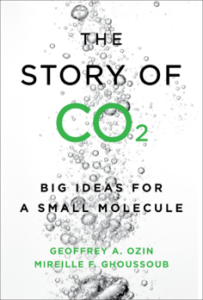 This fascinating book covers all aspects of the story of carbon dioxide (CO2), a chemical intimately woven into the history of Earth, its geology and life, and its role in climate change. Understanding its origin, its chemistry, and how carbon emissions from burning fossil fuels can be reduced through utilization technologies and mitigation strategies gives one hope for the future. The book describes the many complexities of the climate change issue, and the opportunities for society if a cooperative and urgent approach is adopted to reduce CO2 emissions and utilize carbon in new and innovative ways. It should be widely read across the science-policy spectrum, not just by persons working in the environmental field. (PGW)
This fascinating book covers all aspects of the story of carbon dioxide (CO2), a chemical intimately woven into the history of Earth, its geology and life, and its role in climate change. Understanding its origin, its chemistry, and how carbon emissions from burning fossil fuels can be reduced through utilization technologies and mitigation strategies gives one hope for the future. The book describes the many complexities of the climate change issue, and the opportunities for society if a cooperative and urgent approach is adopted to reduce CO2 emissions and utilize carbon in new and innovative ways. It should be widely read across the science-policy spectrum, not just by persons working in the environmental field. (PGW)
~ ~ ~ ~ ~
Although reading digital copies of books may be a practical option, more can be said about reading a printed book than pleasure alone. Winston Churchill’s admonition comes to mind:
“If you cannot read all your books, at any rate handle them, and, as it were, fondle them. Let them fall open where they will. Make a voyage of discovery, taking soundings of uncharted seas.”
The many fine books coming out on the wide span of environmental topics is encouraging. While we are not naïve about the time required to read books, we hope that volumes like the above are noted, read, and thought about by the usually very busy people in influential, policy making positions. We will welcome comments of readers of this blog post. You can reach us at: bertrum.macdonald@dal.ca (BHM), tamanna.moharana@dal.ca (TM), and oceans2@ns.sympatico.ca (PGW).
References
Bogenschneider, K., & Corbett, T. J. (2021). Evidence-based policymaking: Envisioning a new era of theory, research, and practice (2nd ed.). New York and London: Routledge. 430 p. ISBN 978-1-00-305766-6 https://doi.org/10.4324/9781003057666
Mercer, T., Ayres, R., Head, B., & Wanna, J. (Eds.). (2021). Learning policy, doing policy: Interactions between public policy theory, practice and teaching. Acton, Australia: ANU Press. xxi, 329 p. ISBN 978-1-76046219. https://doi.org/10.22459/LPDP.2021 [Free to download]
Oreskes, N. (2021). Science on a mission: How military funding shaped what we do and don’t know about the ocean. University of Chicago Press. x, 738 p. ISBN 978-0-226-73238-1
Ozin, G. A., & Ghoussoub, M. F. (2020). The story of CO2: Big ideas for a small molecule. Toronto and Buffalo: Aevo UTP; University of Toronto Press. 253 p. ISBN 978-1487506360
Tortell, P. (Ed.). (2020). Earth 2020: An insider’s guide to a rapidly changing planet. Cambridge: Open Book Publishers. vi, [iv], 273, [5] p. ISBN 978-1-78374-847-1. https://doi.org/10.11647/OBP.0193
Vohland, K., Land-Zandstra, A., Ceccaroni, L., Lemmens, R., Perelló, J., Ponti, M., Samson, R., & Wagenknecht, K. (Eds.). (2021). The science of citizen science. Cham: Springer International Publishing. vii, 529 p. ISBN 978-3-030-58277-7 https://doi.org/10.1007/978-3-030-58278-4
Authors: Bertrum H. MacDonald, Tamanna Moharana, and Peter G. Wells